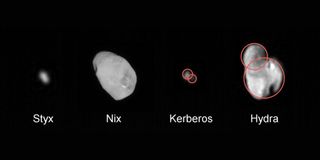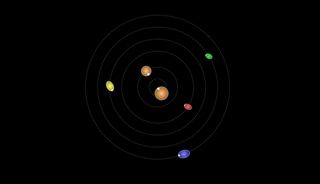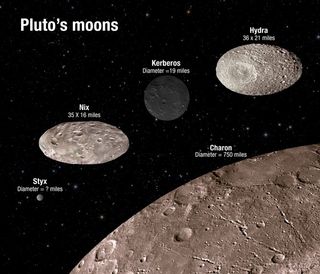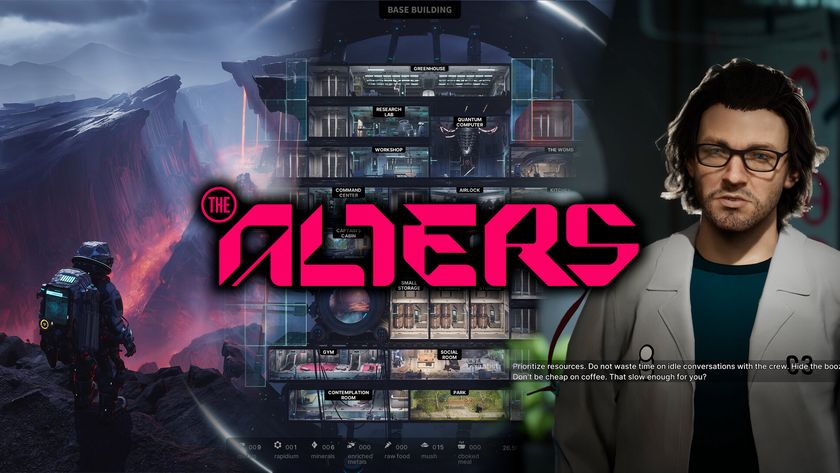Pandemonium! Motion of Pluto's Moons Perplexes Scientists
The orbits of Pluto's four smallest moons are even more chaotic than scientists had expected, according to new results from the New Horizons mission, which made a close flyby of Pluto in July.
"The way I would describe this system is not just chaos, but pandemonium," Mark Showalter, a co-investigator on the New Horizons mission, said today (Nov. 9) during a news conference at the meeting of the Division for Planetary Sciences of the American Astronomical Society. "We honestly have not seen anything like this before, and we still don't know what to make of it."
The new results show that as the four moons orbit Pluto and its largest moon, Charon, some of them are spinning incredibly fast, one is spinning backward against its orbit and some are tilted on their sides. This is in stark contrast to nearly every other moon in Earth's solar system, most of which are locked into a more rigid and unmoving orbit around their parent bodies, making Pluto's moons the wild children of the solar system. [Watch: Pluto's Four Tiny Moons' Topsy-Turvy Tumbles]

Pluto has five moons. Its largest, Charon, has a diameter a little more than half that of its parent body. The two ice dwarfs experience what's known as tidal locking or synchronous rotation, meaning the same side of Charon forever faces the same side of Pluto, even as they orbit around a common point in space. This tight relationship earns them the title of "binary planet."
This spinning duo is orbited by four smaller moons, which scientists only discovered recently, between 2005 and 2013. Using data from the Hubble Space Telescope, scientists showed earlier this year that the four moons are not tidally locked around Pluto and Charon, and that the system might be somewhat chaotic. But now that more data have come down from New Horizons, scientists say things in the system are beyond disorganized — and it's unexplainable.

Showalter said during the news conference that scientists expected to see "little wobbles" in the orbits of the four moons, but instead, they're seeing extremely rapid rotation. Hydra, the most distant of Pluto's moons, is spinning once every 10 hours during its 38-day cycle around Pluto, which means it spins 89 times every orbit.
"If Hydra were spinning much faster, material would fly off its surface due to the centrifugal force," Showalter said in a statement from NASA. During the news conference, he said the other moons are rotating more slowly, but at a rate of six to 10 rotations per orbit around Pluto.
Get the Space.com Newsletter
Breaking space news, the latest updates on rocket launches, skywatching events and more!
"This is unprecedented," Showalter said at the news conference. "We simply have not seen a satellite system that does this."

In addition to these rapid rotations, Pluto's second-closest moon, Nix, is tilted on its axis by 132 degrees and is rotating backward.
Showalter clarified that it is not impossible to imagine that the moons would spin so rapidly following a collision with another object. What is so mysterious is that all four objects are spinning rapidly (it's difficult to imagine a collision that would affect all four of them), and that the gravitational pull of Pluto doesn't appear to have slowed them down, he said.
Typically, the gravity of a parent body would dissipate the planet's rotational motion, "and yet that's not what we're seeing, so that's really the puzzle," Showalter said at the news conference. "The question is, why [don't they] slow down? It's not so much why [are they] so fast."
"There's clearly something fundamental about the dynamics of the system that we do not understand," Showalter said in the statement.
Follow Calla Cofield @callacofield. Follow us @Spacedotcom, Facebook and Google+. Original article on Space.com.
Join our Space Forums to keep talking space on the latest missions, night sky and more! And if you have a news tip, correction or comment, let us know at: community@space.com.

Calla Cofield joined Space.com's crew in October 2014. She enjoys writing about black holes, exploding stars, ripples in space-time, science in comic books, and all the mysteries of the cosmos. Prior to joining Space.com Calla worked as a freelance writer, with her work appearing in APS News, Symmetry magazine, Scientific American, Nature News, Physics World, and others. From 2010 to 2014 she was a producer for The Physics Central Podcast. Previously, Calla worked at the American Museum of Natural History in New York City (hands down the best office building ever) and SLAC National Accelerator Laboratory in California. Calla studied physics at the University of Massachusetts, Amherst and is originally from Sandy, Utah. In 2018, Calla left Space.com to join NASA's Jet Propulsion Laboratory media team where she oversees astronomy, physics, exoplanets and the Cold Atom Lab mission. She has been underground at three of the largest particle accelerators in the world and would really like to know what the heck dark matter is. Contact Calla via: E-Mail – Twitter










